Famiglia : Fagaceae

Text © Prof. Paolo Grossoni

English translation by Mario Beltramini
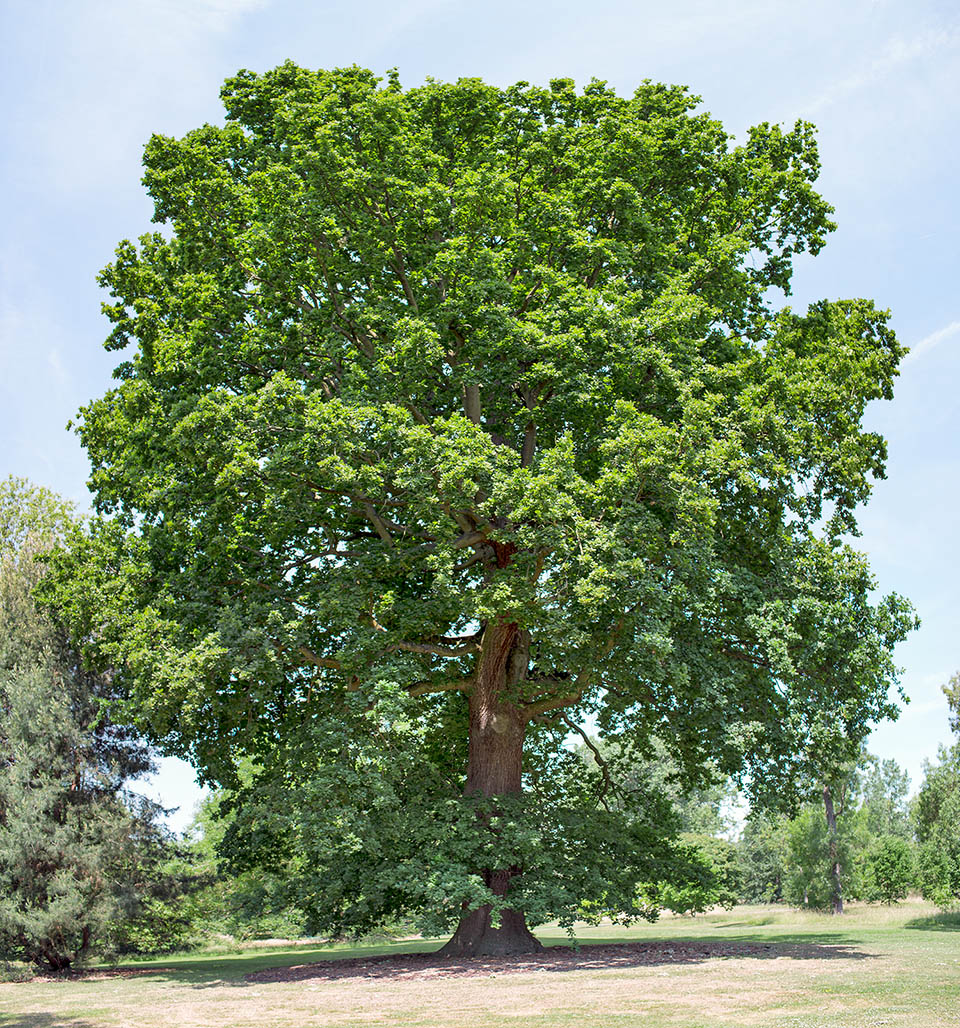
An isolated English oak; the tree was thus able to homogeneously expand its crown that is thick but never dense because the oak is a heliophilous species © Giuseppe Mazza
Quercus robur (farnia in Italian; chêne pédonculé in French; English oak, common oak and pedunculate oak in English; Stieleiche and Deutsche Eiche in German and roble común in Spanish) belongs to the ‘European white oaks’ (section Quercus of the subgenus Quercus) along with sessile oak (Quercus petraea (Matt.) Liebl.), downy oak (Quercus pubescens Willd.), Hungarian oak (Quercus frainetto Ten.) and Pyrenean oak (Quercus pyrenaica Willd.).
The specific epithet ‘robur‘ is a Latin term originally used to characterize the particularly hard and strong timbers then passed to indicate the trees producing these woods and then, par excellence, the deciduous oaks that furnished work timber and finally, figuratively, it has acquired the meaning of ‘robustness’, ‘strength’ and other names of similar meaning.
The English oak is a very long-lived deciduous species of which we know single trees that have exceeded ten centuries of life. In ‘The magic flute’ (‘Die Zauberflöte’) by Wolfgang Amadeus Mozart, Pamina reveals that the flute «[…] Es schnitt in einer Zauberstunde / Mein Vater sie aus tiefstem Grunde / Der tausenj ähr’gen Eiche aus, / Bei Blitz und Donner – Sturm und Braus. » ([…]» He carved it in a magical hour / My father from the deepest root / Of the millenary oak, / Between lightning and thunder, storm and downpour).
Its size and shape are very similar to those of the sessile oak but the English oak is less ramified with long branches more or less sinuous in their part closest to the insertion on the trunk which is massive and cylindrical.
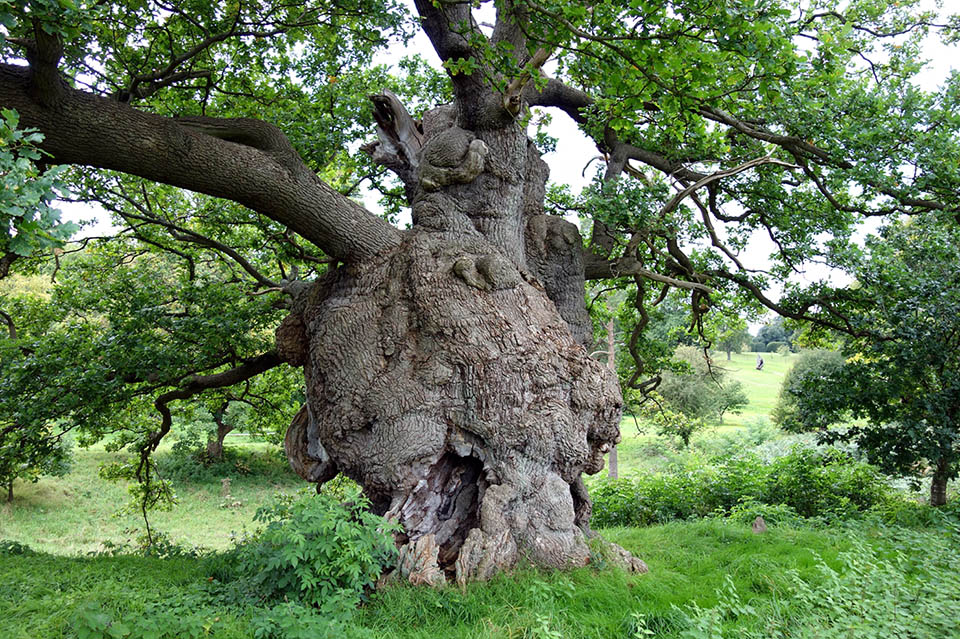
A decidedly old English oak inside Hatfield Park (in Hertfordshire, just north of London). The exaggerated enlargement of the trunk is caused, besides the age, by the practice of pollarding the tree in order to have a contained but very dense crown. Unfortunately the decay in the trunk reduce its strength © Claude Lacourarie
The rhytidome, grey and smooth up to about 20 years old, fissures then in long and deep longitudinal grooves crossed by more superficial transverse grooves that delimit plates having a triangular to trapezoidal section.
The foliage is ample, irregular and never dense; on a tree grown in a woodland it is limited to the upper part of the trunk; the twigs are straight, more or less cylindrical or even ribbed, completely hairless and with pluriperulate buds that, in the distal part of the twig, are very closed each other.
The leaves are deciduous and usually (5) 10-12 (14) cm long and 3-5 cm broad with a very short petiole (3-5 mm); they are obovate with 5-7 pairs of ample lobes, narrow at the base which is more or less asymmetric due to the uneven development of the two small basal ‘earlobes’ and broader in the distal part; their blade initially has a herbaceous consistency then becoming moderately coriaceous. They are totally glabrous, glossy and light green on the upper (adaxial) surface and just lighter on the lower one (abaxial). Being a decidedly heliophilous species, unlike the sessile oak, it has only sun leaves.
After the germination, the rootlet grows forming a long taproot that rapidly develops lateral roots that over time expand becoming, by the age of 70, predominant also because in the meantime the taproot slows down its growth until it stops; in this way, a fairly superficial but expanded rooting apparatus, very robust and consequently rather advantageous for a tree that lives on soils that are always more or less humid and not particularly tenacious.
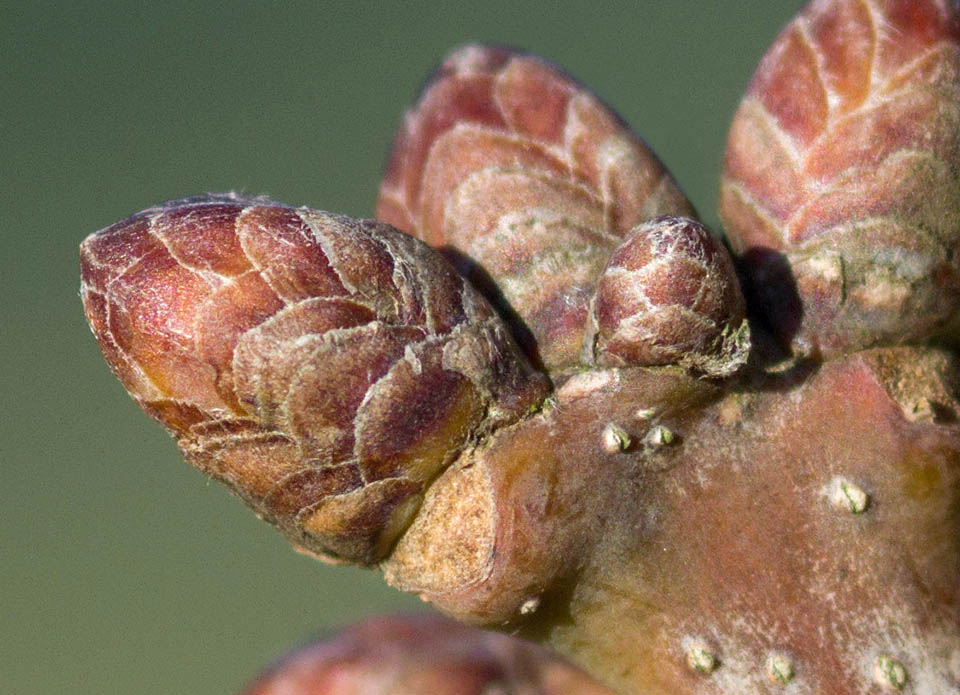
In the English oak the subapical buds not only are very close to each other but they are placed immediately under the apical one. In this way, at the top of the twig the news leaves form a small tuft. Also in other tree species, on long shoots, the leaves display this arrangement. Undoubtedly, the cherry trees are an example of this © Will George
The early development of the secondary roots and the slowdown of in the growth of the taproot allow, during the transplant operations in nursery, to cut the taproot without affecting the future stability of the tree.
The wood is ring-porous, with white-yellowish sapwood and light brown heartwood that, with age, darkens. Like the other deciduous oaks, the wood rays are mostly uniseriate but there are also several (about 5% of the total) that are multiseriate, wide and easily visible.
Quercus robur, like all oaks, is a monoecious species and its blooming is relatively late, in April-May and it coincides with budburst; the male flowers are united in slender and pendulous (2-5) cm catkins carried in the basal part of the twig whilst the female ones are mostly in groups of 2-5 on short erect spikes inserted instead in the apical part at the axil of the leaves, and characterized by a thin glabrous peduncle, 3-5 cm long. The male flowers have greenish yellow perianth and (4) 6-8 (12) stamens; as in all oaks the pistillate one is wrapped in bracts longer than the flower and has, as in most other Fagaceae, 3 styles each with a dark red stigma. The sexual maturity is reached by around the 30 years in the isolated trees whilst it takes twice as many years in a woodland.
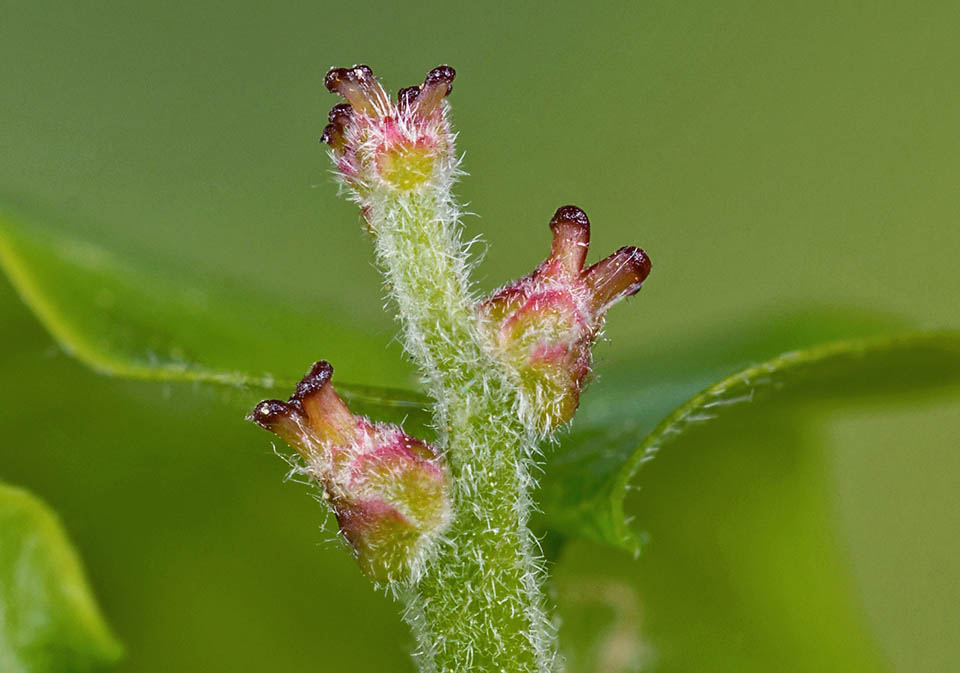
A spikelet with three pistillate flowers on a twig of Quercus robur. The red stigmas are clearly visible © Nikolai Vladimirov
The acorn ripens in the autumn of the same year and at that moment the peduncle, always thin, glossy and glabrous, reaches 5-9 (12) cm in length with 1-5 fruits and it constitutes one of the main morphological elements of this species (synonym is Quercus pedunculata Ehrh.). The acorn has variable size, from 2-4 (5) cm; it has an ovate-oblong shape with a smooth integument olive brown with dark longitudinal stripes and, once desiccated, it turns tawny and loses the streaks; the cupule covers from 1/4 to 1/3 of the acorn and has well adherent scales (only the apex is free) forming a smooth surface. They have a rhombic or triangular shape, those closest to the peduncle are larger (3 mm long and 3-4 mm wide) than the distal ones.
As in all oaks the germination is hypogeal and the seed is not dormant and quickly dies if it does not germinate. The first leaves are subpetiolate and similar to those of the adult tree but remain green throughout the winter.
English oak is the oak with the widest range among all European oaks and, with the sole exception of Iceland, it is present, albeit with different density and distribution, throughout Europe: northwards it reaches 60° latitude (but, due to the Gulf Stream, up to the 63° along the Atlantic coasts of Norway), while southwards penetrates the Mediterranean basin through the three large peninsulas (Iberian, Italian and the Balkans), lacking however in the large central-northern islands (Sicily, Sardinia, Corsica and Balearic Islands); from the Atlantic coasts of the Iberian peninsula and those of the British Isles it reaches the Ural mountains; in Asia, the distribution continues along Anatolia reaching the foothills of the Caucasus.
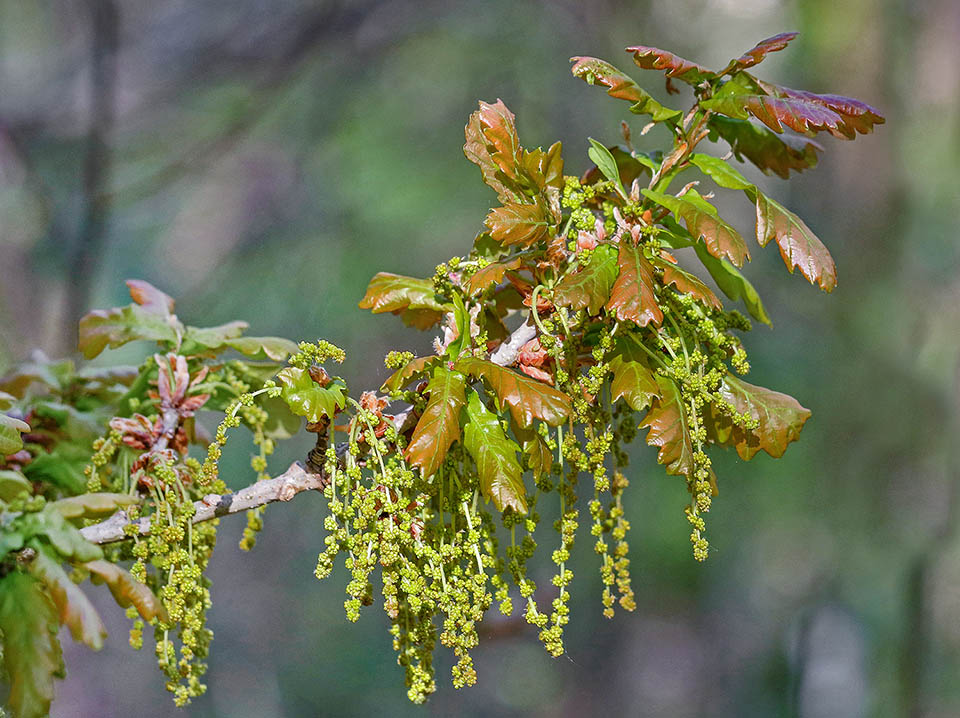
Young twig with several staminate catkins. Blooming and budburst occur at same time. When catkins are abundant the plant turns yellowish for a few days © John Tomset
Even if the period of budburst is conditioned by temperature and availability of water, in the same area the beginning of leaf unfolding in Quercus robur is usually postponed by a few days compared to that of Quercus petraea while it is brought anticipated forward by more or less time interval compared to Quercus pubescens grown in a same area. The English oak is a microthermal species that can tolerate even long and cold winters but that requires light and intense summer heat, environments with a sufficiently humid air and, especially, soils with superficial waters and/or with free and available groundwater during the whole year. It prefers deep, fresh, rich in nutrients soils and in these conditions can tolerate periods of submersion of the roots even for 2-3 consecutive months.
The amplitude of the range has determined two classes of ecotypes: the westernmost ones (decidedly oceanic) which tolerate not too low thermal limits (around -15/-20 °C) and which can overcome the summer dryness only if the water is always available and the more easternmost (continental) ones that tolerate colder and longer winters being able, in various populations, to overcome also the late frosts because their budburst occurs very late.
In this regard, the French people distinguish a late-sprouting ecotype (Quercus robur var. tardiva Mathieu & Fliche) called ‘chêne de juin‘ wich, sprouting about one (two) months late, usually passes unscathed not only the late frosts but also the phyllophagous phases of the caterpillars of several moths.
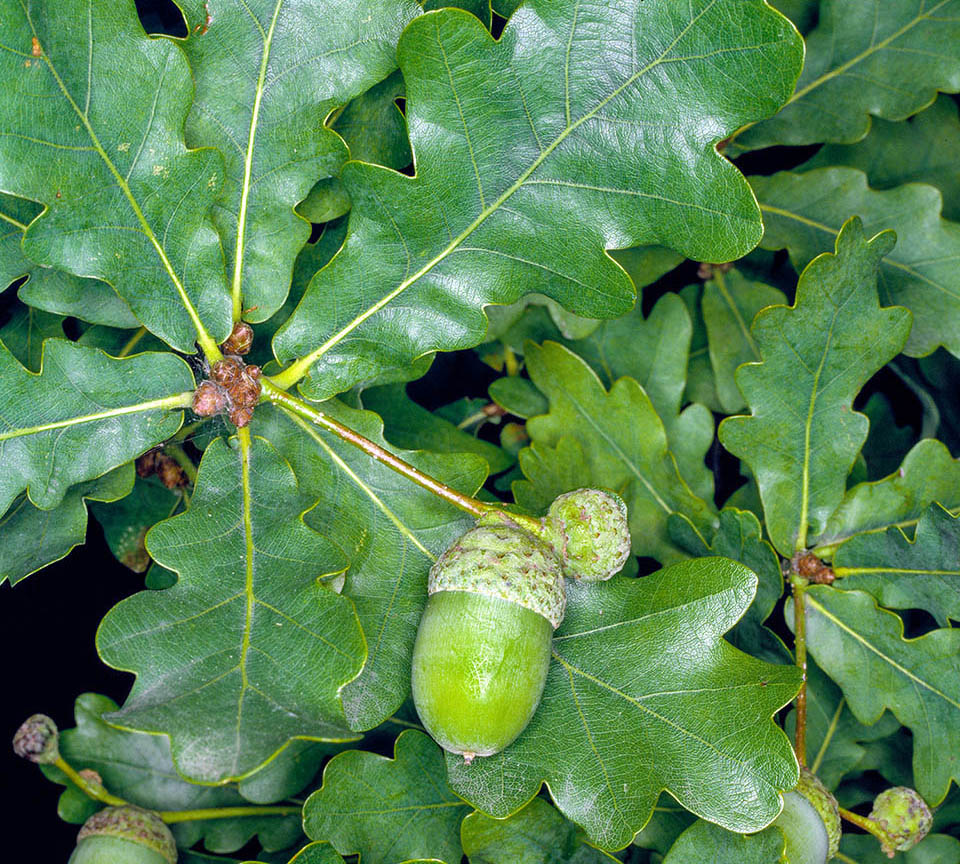
Sprig of English oak with leaves spirally arranged to better intercept sunlight. In addition to the hairless twigs, other characters useful for recognizing the species are the shortness of the petiole and the broader blade towards the apex (obovate leaf). In the picture the long pedunculated acorns, are now close to ripening © Giuseppe Mazza
The requirement for permanently humid environments with the possibility of tolerating long-lasting floodings actually link this oak especially to the floodplains and along humid valleys and depressions in more or less mixed woodlands, be they high forests or coppices, alternating with wetlands, meadows and fields in turn bordered by shrubby hedges or rows of fruit trees.
Especially in the Mediterranean regions most of these environments have been now drained and reclaimed by man and transformed in agricultural lands; only in few cases old forests still used as hunting reserves and woodlands, generally along the water streams and in the humid zones, have been conserved and where, nowadays, the English oak associates with Alnus glutinosa, Fraxinus angustifolia, Populus nigra and Populus alba, Ulmus minor, Carpinus betulus, Salix alba, etc.
In north-central and eastern Europe this oak is mainly associated in forests, where the most economically useful species are often favoured and valued by man, with Carpinus betulus, Prunus avium and Prunus padus, Fraxinus excelsior, Acer campestre, Betula pendula, Populus tremula, Salix fragilis and, where the soils are not too humid, with Quercus petraea and Fagus sylvatica and other mesophylous or meso-hygrophilous trees and shrubs.
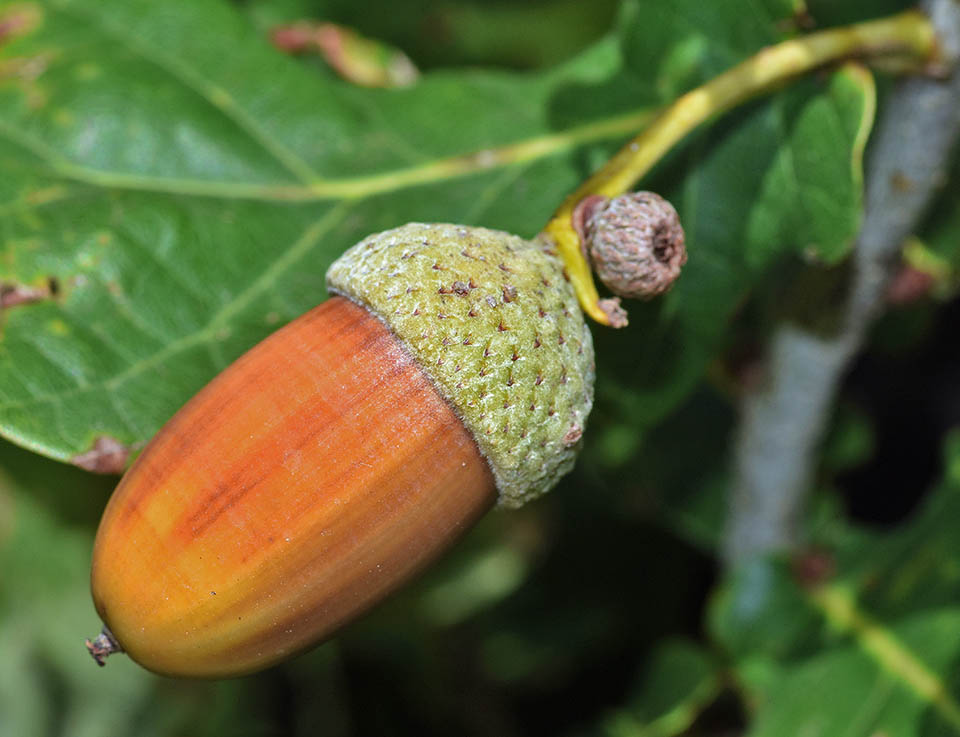
Ripe acorn of English oak. It has become reddish brown and its integument is marked by many dark stripes that disappear when dehydrated © Thomas Palmer
Its requirements in humidity make this oak, in dry years, particularly susceptible to the environmental stresses that manifest themselves with desiccations and alterations of the twigs especially in the upper part of the crown.
Some of the ecological requirements of English oak have been already been anticipated; in more detail, this oak is very heliophilous and well tolerates low temperatures (even for long periods in the most continental populations) but needs summers, even short, but warm. Anyway, the availability of water in the soil must never fail, so this oak always prefers wetlands and banks of rivers but, in any case, the soils must always be fresh and not too compact.
In this last case the English oak is not further limited by the substratum as it can easily grow on acidic as well as alkaline soils, provided they are not too calcareous, accepting also clayey soils if constantly supplied with water; in these circumstances it tolerates very well long periods of submersion of the root system. Under optimal environmental conditions a second flow of sprouting it is not rare.
The English oak has marked pioneering attitudes: it is heliophilous, quite indifferent about the type of soil, tolerates low temperatures and is decidedly hygrophilous. With these capacities, as the temperatures rose after the last glaciation, it has been one of the most relevant tree species that has participated in the green recolonization of central and northern Europe mainly going up the great rivers and establishing itself in the marshy areas.
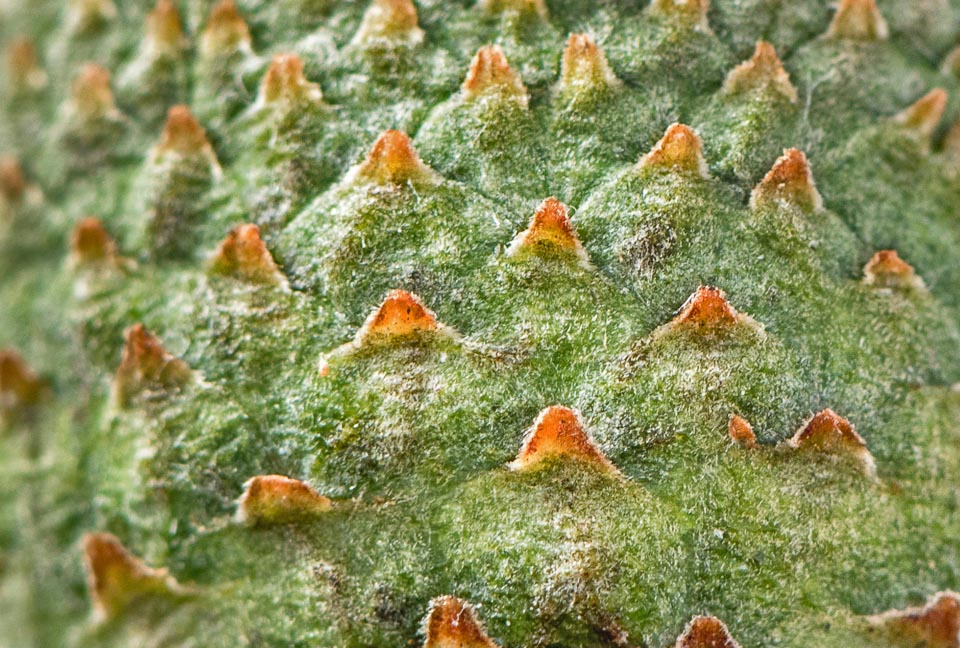
English oaks acorn cupules are formed by very close decurrent small scales and only the apex remains free and reflected backwards © John Penberthy ARPS
In its expansion it has been markedly assisted by the Eurasian jay (Garrulus glandarius) and by squirrels and several other rodents that have disseminated the acorns, too heavy for wind dispersal, even at much greater distances than those otherwise possible. Subsequently, less hygrophilous and, above all, less heliophilous species have penetrated and in many less humid areas have then replaced the English oaks.
The wood is more or less light brown but aging it becomes darker. Though sometimes rated slightly lower quality than that of Quercus petraea, it is however a hard wood, resistant and durable over time but also easy to work. It is a very sought-after wood for numerous uses: it serves for the construction of ships and buildings and to produce beams, poles, furniture, parquetry and staves for ‘barriques’; it is also used for plywoods, veneerings and for the production of cellulose. It furnishes an excellent fuel both as wood and as coal. ‘Slavonian oak’ wood, used for the aging of finest wines and spirits, is (or should be) preferably obtained from English oak and not from sessile oak.
Like all oaks, also English oak has a great importance in maintaining high the level of the biodiversity of biocenosis by hosting numerous animal species, especially arthropods and birds, and providing various mammals (from rodents to ungulates) nourishment especially during the cold season.
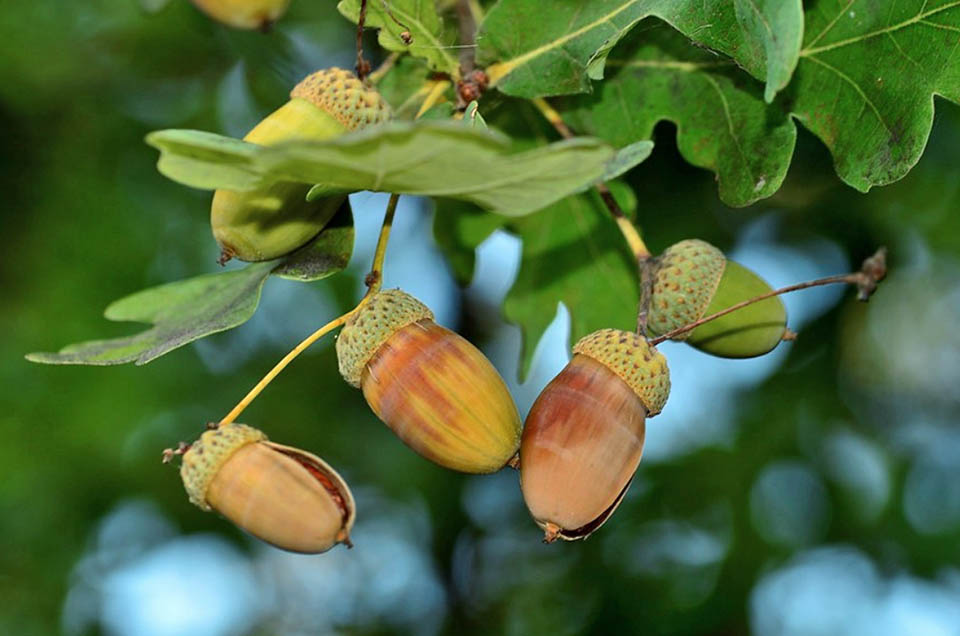
The acorns practically cannot be stored because are non-dormant seeds. They must germinate by autumn just on the ground so that, after a rain, sometimes some acorns of the English oak still germinate on the tree. Isolated English oak trees can reach sexual maturity around the age of 30; otherwise, in forest, it takes about double the time © Detlef Karbe
The forests of English oak, or with the participation of the same oak, are especially important for pig breeding, but this oak, due to its characteristics, appearance and size, is often used for ornamental purposes even with the numerous varieties selected by man according to the form of the crown (‘Alpha’, ‘Beta’, ‘Compacta’, ‘Fastigiata’ (with numerous variations), ‘Pendula’, ‘Tortuosa’, etc.) or to the shape of the leaves (‘Cristata’, ‘Cocullata’, ‘Doumetii’, ‘Fennessy’, ‘Filicifolia’, ‘Salicifolia’, etc.) or to their colour (‘Argenteomarginata’, ‘Atropurpurea’, ‘Aureomarginata’, ‘Concordia’, ‘Purpurea’, ‘Timuki’, ‘Variegata’, etc.). Of all these, the ‘Fastigiata’ varieties (often reported as natural form: Quercus robur var. fastigiata) are certainly the most cultivated. In 1985 Alice McArdle and Frank Santamour Jr., excluding the synonymies, have listed 119 forms and varieties of Quercus robur in Great Britain alone.
This wide variety of forms, and of ecotypes, has often led to classify some of them as a species in itself (Quercus brutia Ten., Quercus estremadurensis O. Schwarz, Quercus haas Kotschy, Quercus pedunculiflora K.Koch), but the most recent researches have led to consider these taxa as synonyms of Quercus robur. Throughout its range English oak may present forms having intermediate characters with other species of the subgenus Quercus; as already mentioned for the sessile oak, also in these instances in many specimens these characters are “diluted” due to the probable introgressions (backcrosses).
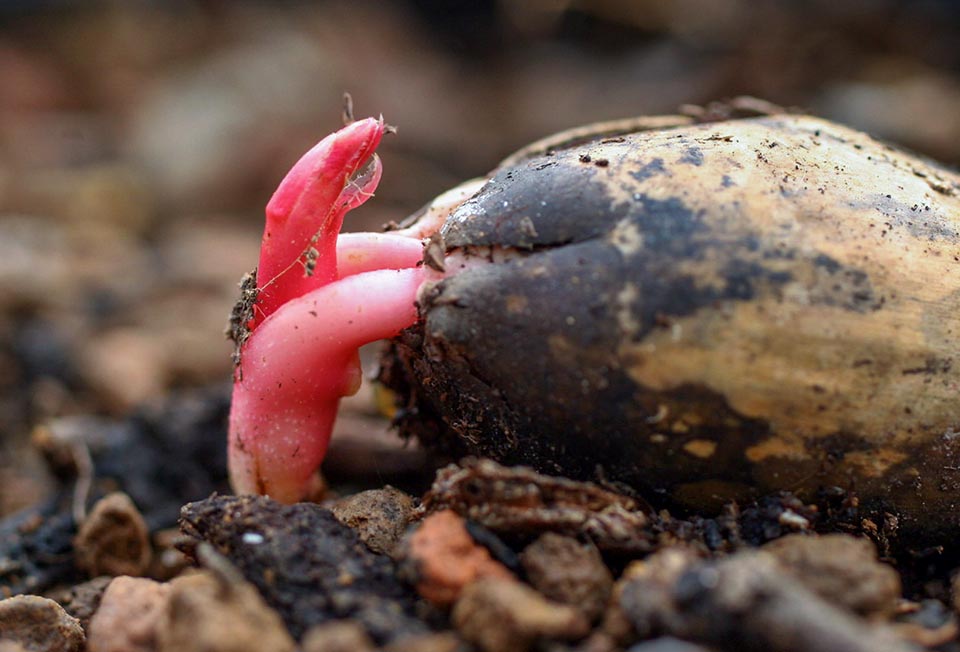
Germinating acorn. The taproot has penetrated the soil and the epicotylar axis has already appeared on which the first leaflets will emerge to carry out photosynthesis. Being hypogeal germination, its cotyledons remain enclosed in the integuments and nourish the embryo exclusively through the accumulated reserves © Kevin Bailey
Natural hybrids are mainly with oaks of the same section such as Quercus ×andegavensis (with Quercus pyrenaica), Quercus ×coutinhoi (with Quercus faginea), Quercus ×haynaldiana (with Quercus frainetto), Quercus ×kerneri (with Quercus pubescens) and Quercus ×rosacea (with Quercus petraea) but hybrids have been obtained also with species of other sections (i.e. Quercus ×turneri with the holm oak and Quercus ×hickelii with the Caucasian Quercus pontica K.Koch). The man has also been able to obtain intercontinental hybrids such as Quercus ×sargentii, hybrid with Quercus michauxii Nutt. of eastern US.
The most important diseases that may affect English oaks are roughly the same that affect the other European deciduous oaks: powdery mildew (Erysiphe alphitoides), wood decay and, especially, root rot (Daedalea quercina, Armillaria mellea, Inonotus dryadeus, Ganoderma sp.pl., Fomitoporia sp.pl., etc.) and the ‘charcoal canker’, caused by Biscogniauxia mediterranea. Recently very serious damages are to be attributed to the oomycete Phytophthora ramorum, the primary agent of both syndromes of a complex disorder called SOD («Sudden Oak Death») and COD («Chronic Oak Decline»).
The fungus causes necrosis called “charcoal canker”
Is to be kept in mind that living in environments with a high atmospheric humidity, the leaves of English oak are frequently infected by the powdery mildew.
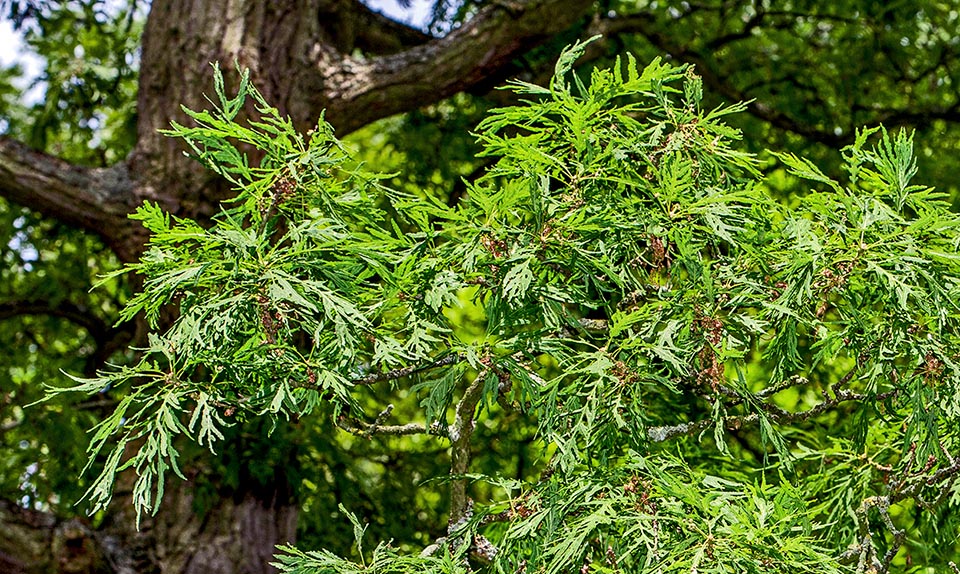
For ornamental purposes, man has selected several varieties of Quercus robur. Among these, the most used is the var. Fastigiata because it has a narrow shape and, therefore, not bulky; also interesting is the variety ‘Filicifolia’ that, like others more or less similar, has leaves deeply laciniate so much to look like fronds of ferns © Giuseppe Mazza
Particular attention is paid to that the agent of the withering of oak wilting (Ceratocystis fagacearum) does not reach Europe;, it is a tracheomycosis that in the central and eastern US represents the most dangerous plant disease for oaks because it easily causes a rapid death of the tree.
Young twigs, buds, leaves and reproductive organs are used by various gall wasps of the Cynipidae family to lay their eggs inside; as the larvae develop, stimulate plant tissues to form galls, even large ones (up to 40-50 mm in diameter) having different shapes and colours. Size and shape of the galls are specific to each insect species. The presence of galls, even when numerous on the same leaf, has no repercussions on the plant unless the spores of some parasitic fungus penetrate in the gall through the exit-hole left by the adult emerged.
In urban greenery, we are witnessing an increase in cases of decay and even of death of English oak trees as a consequence of the air pollution and, above all, of the increasingly accentuated summer drought. This deterioration also favours the affirmation or the worsening of wood decay and of root rot with the obvious catastrophic outcome not only of the death of the tree but even of the frequent detaching of large branches or of the collapse of the tree itself.
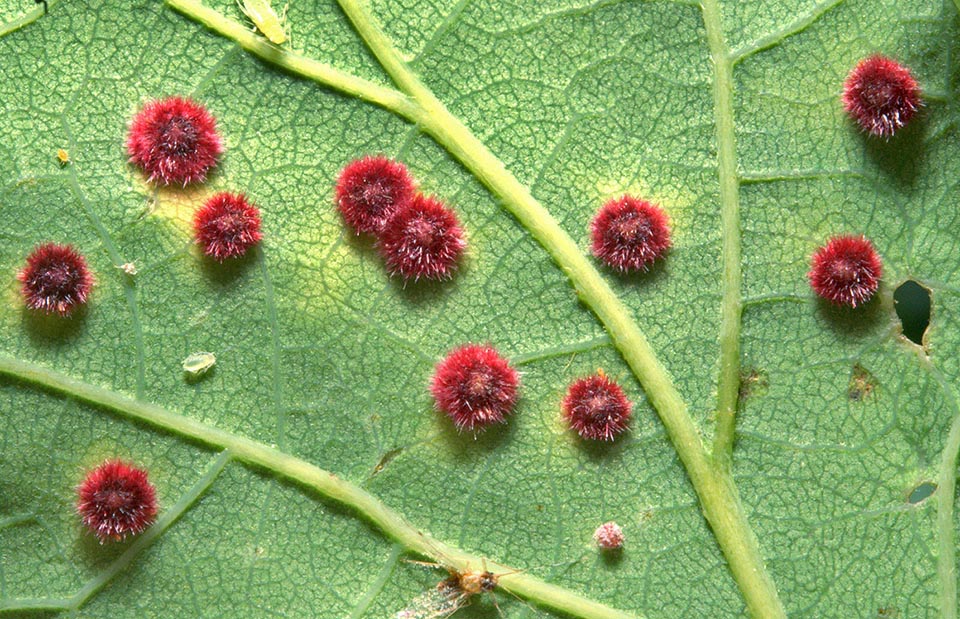
Like the other oaks also the English oak is parasitized by several species of gall wasps that lay their eggs in the leaves, in the twigs or in the reproductive organs when in development. The plant tissues then react to this attack by producing new cells that form a swelling (the so-called gall) hat has a highly specific shape and colour wich mainly depend on the insect that laid the eggs there. In this image, the galls, similar to some tiny sea urchins, are caused by Neuroterus tricolor © Brian Eversham
In 1993, Otto K.A. Schwarz had proposed the division of this species in the two subspecies Quercus robur subsp. robur and Quercus robur subsp. brutia but the current criticism does not consider this distinction valid as well as assesses the correlate taxa (Quercus estremadurensis, Quercus haas and Quercus pedunculiflora) not sufficiently differentiated.
The English oak stands out from other European deciduous oaks for its very short petiole, for the leaf completely glabrous and enlarged in the distal part and, above all, because the spikelet is long pedunculated; furthermore, it differs from the downy oak and from the Pyrenean oak also because leaves and twigs are glabrous and not pubescent.
In addition to Quercus pedunculata Ehrh. (1790) and, with the same name, Quercus pedunculata Hoffm. (1791), there are about one hundred synonyms of this species among which Quercus femina Mill. (1768), Quercus fastigiata Lam. (1785), Quercus racemosa Lam. (1785), Quercus longaeva Salisb. (1796), Quercus viminalis Bosc (1807), Quercus auzin Secondat ex Bosc (1807), Quercus pyramidalis C.C.Gmel. (1808), Quercus microcarpa Lapeyr. (1813), Quercus brutia Ten. (1825), Quercus pedunculiflora K.Koch (1849), Quercus hyemalis Steven (1857), Quercus haas Kotschy (1858), Quercus lucorum Vuk. (1883), Quercus welandii Simonk. (1883), Quercus robustissima Simonk. (1890), Quercus vulgaris Bubani (1897), Quercus longiglans Debeaux (1898), Quercus estremadurensis O.Schwarz (1935).
→ To appreciate the biodiversity within the FAGACEAE family please click here.
